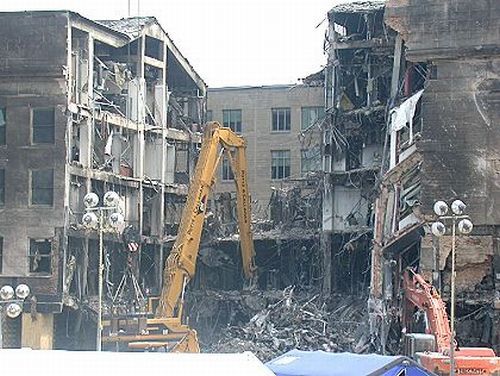By Craig McKee
A great deal has been written about the evidence for explosives in the World Trade Center, but not enough attention has been paid to the evidence that bombs were detonated in the Pentagon on Sept. 11, 2001.
As I wrote in my Oct. 2, 2010 post, “How could Flight 77 have caused interior Pentagon damage on 9/11?”, there was a great deal more damage done to the interior of the Pentagon than a plane impact could account for – or any impact from the outside for that matter.
We know that the government’s conspiracy theory states that American Airlines Flight 77 penetrated the Pentagon at roughly a 45-degree angle and managed to go through three rings of the Pentagon, punching a round exit hole in the inside wall of the C Ring (the middle of the five Pentagon rings; E is on the outside and A is the innermost ring).
We also know that photographs of the damage to the outside of the building simply don’t fit with the damage inside – unless it resulted from a source other than the plane impact. The image at the top of this post seems impossible to reconcile with a plane going through three rings of the building.
Another critical contradiction is that witnesses have described destruction and numerous deaths in the A and B rings of the building, well beyond the alleged exit hole. Something doesn’t add up.
Robert Andrews, then acting assistant secretary of defense for special operations and low intensity conflict, told former White House official turned whistle blower Barbara Honegger that after entering the corridor in the A ring, he found himself stepping over dead bodies. How did these people die if the plane only made it as far as the C ring?
And as I recounted in my earlier post, a Washington Post story from Sept. 11 (“Extensive casualties in wake of Pentagon attack” – Barbara Vobejda) reported that a Marine major who asked to remain anonymous said that he and others rushed to the section of the Pentagon that appeared to be the most heavily damaged – the B Ring between the 4th and 5th corridors.
According to Vobejda, the major said he was part of a make-shift rescue crew that tried to pull out a civilian who was pinned by fallen pipes and other debris. As the hot, thick, black smoke built up, the men passed wet t-shirts to one another and removed debris piece by piece in assembly-line fashion. He added that the B Ring was “decimated.”
Through the Honegger’s reporting, we have learned that many Pentagon employees have described explosions inside the building. Her reports have been cited and expanded upon in Dr. David Ray Griffin in his book The New Pearl Harbor Revisited.
Among the most important witnesses to report explosions inside the building was April Gallop, who was an executive administrative assistant with the Army, and was coming back to work after a maternity leave. She arrived at the Pentagon with her newborn in tow.
In a March 2007 interview with Honegger, Gallop says she heard a large boom that she thought was a bomb at the exact second that she turned her computer on. The ceiling caved in and she lost consciousness. When she regained consciousness, she was helped to exit the building through the alleged “impact hole.” But as she did so, she says she saw absolutely no evidence of a plane wreck.
“I didn’t see anything that would make me think there was a plane,” she said. She said she saw no seats, no luggage, and no evidence of jet fuel. And she said, “I didn’t see anything on the lawn.”
Gallop later told Army officials that she thought her computer had triggered a bomb, saying that the only fire she saw was coming out of computers.
NPH Revisited (page 101), lists several people who claim they thought bombs had gone off in the Pentagon. Among those were Michael J. Nielsen, a civilian auditor for the Army (heard people running through the corridors yelling that bombs were going off); and Lt. Nancy McKeown (yelled “bomb!” as ceiling tiles fell) Also, journalist Steve Vogel, author of The Pentagon: A History, said in the book that almost no one he talked to had any idea that a plane had hit the building; they all thought it was a bomb.
But the most interesting account is that of Don Perkal, the deputy General Counsel, Washington Headquarters Services, Office of the Secretary of Defense. Perkal reported that he clearly smelled cordite after the explosion and after he exited from his office: “Even before I stepped outside, I smelled the cordite. Then I knew explosives had been set off somewhere.”
And crucially, he also reported leaving the building after two explosions went off a few minutes apart. Despite this, Perkal believes that a plane hit the building.
This was echoed by Pentagon attorney Gilah Goldsmith, who reported that after hearing a loud boom she saw a large black cloud of smoke. She said she also smelled cordite or gun smoke. This account can be found in NPH Revisited and in Eric Bart’s extensive Pentagon Attack Eyewitness Account Compilation.
There are other critical issues that have to be looked at in relation to the Pentagon attack, namely the exact timing of the alleged impact, the records that were destroyed, and why the flight path recounted by witnesses is incompatible with the official account.

 November 9, 2010
November 9, 2010
Most incriminating of all
Government’s confiscation and theft of ALL monitoring videos from that day.
Absolutely right. And I love the explanations given for this by apologists for the official story. “Governments just hate giving out information.” Anybody with common sense can see that this is beyond suspicious. Thanks for commenting.
People are CRAZY thing that we shot misdials in to our pentagon.